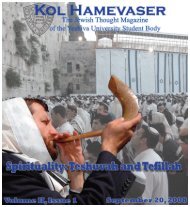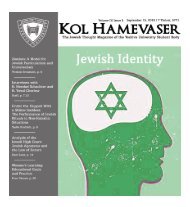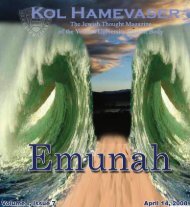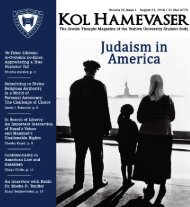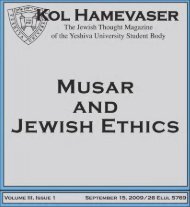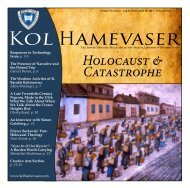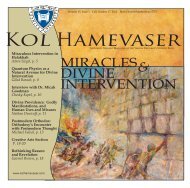Create successful ePaper yourself
Turn your PDF publications into a flip-book with our unique Google optimized e-Paper software.
eing quality-centered, he naturally lives a life<br />
of closeness to people <strong>and</strong> to his undertakings.<br />
His life is a chain of ends, of moments, <strong>and</strong> not<br />
a string of means. Since he cares not for glory,<br />
he can honestly rejoice over his friend’s<br />
achievements. Since accumulation <strong>and</strong> accomplishment<br />
do not interest him, he can surrender<br />
himself to moments <strong>and</strong> live in the now. This<br />
is why spiritual people tend to be adept at <strong>and</strong><br />
passionate about tefillah, zemirah (singing),<br />
<strong>and</strong> rikkud (dance): these things are amorphous,<br />
affective, <strong>and</strong> qualitative in nature, requiring<br />
devotion to the moment, <strong>and</strong> they do<br />
not lend themselves to measurements <strong>and</strong><br />
quantities. They are all about connection <strong>and</strong><br />
not at all about accumulation.<br />
<strong>Halakhah</strong> may be highly quantitative in<br />
nature, but it nevertheless dem<strong>and</strong>s a spiritual<br />
life from Jews. After all, the great goals of <strong>Halakhah</strong><br />
<strong>and</strong> Torah are fear of God, love of God,<br />
knowledge of God, love for one’s fellow, humility,<br />
justice, truth, <strong>and</strong> deveikut. We can<br />
measure the heights of our sukkot, the volume<br />
of our mikva’ot, the length of tsitsit, the size of<br />
our wine glasses, but can we measure love of<br />
God? Fear of God? Can we measure a Jew’s<br />
sense of justice or goodness toward his fellow<br />
man? Can we measure one’s immersion in<br />
prayer? Of course we cannot; <strong>and</strong> maybe that<br />
is because, more than anything, “God requires<br />
the heart” in our dealings with Him <strong>and</strong> in our<br />
dealings with each other, <strong>and</strong> matters of the<br />
heart defy quantity. vi It is impossible to measure<br />
the love of a parent for a child or the love<br />
of a husb<strong>and</strong> for his wife, <strong>and</strong> one cannot com-<br />
pete or win in this realm either. It would be absurd<br />
to compare two happily married couples<br />
<strong>and</strong> decide which marriage is more successful<br />
or which spouses love each other more. How<br />
would you go about calculating it? So, too,<br />
how would you go about comparing the righteousness<br />
of one tsaddik to another? For example,<br />
who was more righteous, R. Kook or the<br />
Hafets Hayyim? How would you figure it<br />
out? vii This is a stupid question! Judaism is<br />
about relationships, sacred moments, <strong>and</strong> matters<br />
of the heart. It may be quantity-laden, but<br />
it is spiritually centered.<br />
4.<br />
The stereotypical YC student is both<br />
Adam the First <strong>and</strong> Spiritual Man. The contradictions<br />
which plague him, arising from this<br />
dichotomy, are not unique to him but are experienced<br />
to some extent by all honest religious<br />
people in the world – a world which, by the<br />
way, has been quantity-driven since the dawn<br />
of time. Nevertheless, the tensions that religion<br />
<strong>Halakhah</strong> <strong>and</strong> <strong>Minhag</strong><br />
creates, <strong>and</strong> the jarring oscillations it produces<br />
in the dichotomous man, are intensified in the<br />
soul of the YC student, for he finds himself in<br />
the eerie twilight zone that is both a yeshivah<br />
<strong>and</strong> a college.<br />
But, as I have noted, it is not the college<br />
catalogue which intensifies the sting of his already-frayed<br />
existence. He may not like having<br />
to read Rashi in the morning (or early afternoon)<br />
<strong>and</strong> Toni Morrison in the later afternoon,<br />
but the content clash is not what is really eating<br />
him. What is troubling him, what is exacerbating<br />
the pain of his imbalanced life, is the experiential<br />
conflict that the twilight zone<br />
creates. For the value systems that the yeshivah<br />
<strong>and</strong> the college are presenting are antithetical<br />
to each other.<br />
The cause of the exacerbation can be<br />
stated quite simply: colleges promote quantity<br />
<strong>and</strong> yeshivot traditionally promote spirituality.<br />
Who are the heroes, the giants, the gedolim of<br />
colleges? Why, the professors, of course! And<br />
which men of yeshivot are traditionally granted<br />
the equivalent appellations? The talmidei<br />
hakhamim <strong>and</strong> the tsaddikim. Which undergraduates<br />
are the most valued in professors’<br />
eyes? The ones who think well, write well, <strong>and</strong><br />
who will go on to graduate schools, doctoral<br />
programs, <strong>and</strong> who will produce thick, footnote-heavy<br />
dissertations. viii And which<br />
bahurim are (or should be) the most favored in<br />
the Rashei Yeshivah’s eyes? The ones with<br />
heads on their shoulders, who surround themselves<br />
with holiness, who devote themselves to<br />
achieving the greatest goals of Torah wisdom<br />
“We can measure the heights of our sukkot, the<br />
volume of our mikva’ot, the length of tsitsit, the<br />
size of our wine glasses, but can we measure<br />
love of God? Fear of God? Can we measure a<br />
Jew’s sense of justice or goodness toward his<br />
fellow man?”<br />
<strong>and</strong> <strong>Halakhah</strong> (i.e. fear of God, love of God,<br />
knowledge of God, love for one’s fellow, humility,<br />
justice, truth, <strong>and</strong> deveikut).<br />
It is not the substance of academic studies<br />
that is necessarily in opposition to a yeshivah’s<br />
values, but the cult of academia. Academia is<br />
about quantity <strong>and</strong> Torah is about spirituality;<br />
for example, in order for a college professor to<br />
achieve that most hallowed of academic<br />
dreams, tenure, he or she needs to publish significantly.<br />
Not only that, but he must write like<br />
an academic! (If this is not quantity-centeredness<br />
<strong>and</strong> distance-living, then I do not know<br />
what is.) Sure, quality of work is also evaluated,<br />
but as important as anything in the path<br />
to tenure is the quantity of published works.<br />
Isn’t it quantity-centeredness that inspires academics<br />
to chop up their dissertations into 23<br />
published articles, half of which share the same<br />
thesis?<br />
Isn’t the pull of quantity-centeredness responsible<br />
for the compulsive writing of footnotes,<br />
endnotes, backnotes, frontnotes <strong>and</strong><br />
sidenotes? Indeed, academic articles often take<br />
place below the footnote line! This is because<br />
the archetypal academic is an Adam the First;<br />
he or she is after glory <strong>and</strong> afraid of disappearing.<br />
His outlook is in complete opposition to<br />
the spiritual person’s; <strong>and</strong> the culture of academia,<br />
which is quantity-centered <strong>and</strong> quantitysaturated,<br />
contradicts the values of a typical<br />
yeshivah, which promotes axiomatic Jewish<br />
principles that are affective, amorphous, <strong>and</strong><br />
spiritual.<br />
But the conflict runs deeper at our college,<br />
<strong>and</strong> the confusion intensifies still. YC has managed<br />
to produce a twilight zone within a twilight<br />
zone.<br />
Volume III, Issue 7 www.kolhamevaser.com<br />
5.<br />
Even more discouraging for the YC student<br />
than the tension he feels from his attraction<br />
to two opposing value-systems <strong>and</strong> modes<br />
of living is the confusion <strong>and</strong> disheartenment<br />
he experiences when the lines are blurred <strong>and</strong><br />
the opposing forces in his life are confused.<br />
Navigating through an existence of quantitative<br />
desires on the one h<strong>and</strong> <strong>and</strong> spiritual ones<br />
on the other is quite challenging, but confusing<br />
spirituality with quantitative living makes<br />
thriving as a happy religious Jew impossible.<br />
Unfortunately, Yeshiva College has allowed,<br />
encouraged, <strong>and</strong> promoted such confusion on<br />
campus.<br />
Talmud Torah has always invited pitfalls<br />
of elitism, arrogance, <strong>and</strong> kavod; one need only<br />
glance through the Mishnayot of Pirkei Avot to<br />
realize that the sages were well aware of this<br />
challenge. For thous<strong>and</strong>s of years, Jews have<br />
been mistakenly viewing their learning of the<br />
Law as a purely quantitative endeavor <strong>and</strong> their<br />
knowledge as a tool for increasing their kavod;<br />
but YC took it to the next level. YC did not<br />
only let its talmidei hakhamim sit at the front<br />
of the study hall; it awarded them for their<br />
Torah scholarship with plaques, books <strong>and</strong><br />
prizes. Chairs were created – chairs of Bible,<br />
chairs of Talmud, <strong>and</strong> chairs of Jewish philosophy.<br />
Awards were h<strong>and</strong>ed out annually to the<br />
finest students in MYP, BMP, IBC, <strong>and</strong> Mechinah.<br />
Elite Torah fellowships <strong>and</strong> kolelim were<br />
established <strong>and</strong> a Yeshiva Honors Program<br />
arose. But well before the YHP came into existence,<br />
there was the academic Jewish studies<br />
curriculum. This curriculum, though teaching<br />
Jewish studies, was made part of the college<br />
<strong>and</strong> not the yeshivah <strong>and</strong> represented a great<br />
oxymoron. The oxymoronic nature of this program<br />
lay not in its method, for the study of<br />
Torah has always been academic at least in<br />
part, but in its message that the quantity-driven<br />
world of academia could possibly harmonize<br />
with the yeshivah student’s spiritual life, of<br />
which talmud Torah occupies a central role.<br />
As such mixed messages abound, it is no<br />
small wonder that some students mistake their<br />
study of Torah for a quantitative enterprise. It<br />
is no wonder that some learn Torah for fame<br />
<strong>and</strong> the writing of articles; that students care<br />
more about finishing tractates of Talmud than<br />
actually learning them; or that talmidim aspire<br />
“Navigating through an existence of quantitative<br />
desires on the one h<strong>and</strong> <strong>and</strong> spiritual ones on the other<br />
is quite challenging, but confusing spirituality with<br />
quantitative living makes thriving as a happy<br />
religious Jew impossible.”<br />
more to the “Most High <strong>Kol</strong>lel” (<strong>Kol</strong>el Elyon) ix<br />
than to the Most High, or that the shi’ur one attends<br />
is a matter of kavod. But this blurring of<br />
boundaries does not end with the quantification<br />
of Torah study; rather, it extends to the Yeshiva<br />
College student’s entire religious life as well.<br />
Specifically, the confusion manifests itself in<br />
the bahur yeshivah’s setting of quantitative<br />
spiritual goals, which is a contradiction in<br />
terms.<br />
6.<br />
Avodat Hashem is unlike a weight-loss<br />
program. A Yid cannot simply hop on a spiritual<br />
treadmill for two weeks <strong>and</strong> afterwards<br />
weigh himself on a scale of frumkayt. Spirituality,<br />
by definition, defies such quantification.<br />
Nevertheless, there are those of our institution<br />
who pursue this type of spiritual routine. Some<br />
students may pursue it by deciding to pray with<br />
kavvanah for two weeks straight, while others<br />
may attempt it by committing to learn night<br />
seder with greater passion. These goals are admirable,<br />
but they are also doomed to failure,<br />
because as soon as one sets a quantitative goal<br />
for an amorphous, spiritual act, that act is<br />
drained of all its life <strong>and</strong> dries up like an etrog<br />
in the sun. And as soon as one builds a spiritual<br />
life around such an approach, one’s world becomes<br />
empty, for quantity-centeredness transforms<br />
man’s actions into means, <strong>and</strong> Avodat<br />
Hashem, at its essence, means lishmah, means<br />
being in the moment, performing the deed for<br />
itself.<br />
Li-Shemah <strong>and</strong> spirituality become especially<br />
difficult principles to live by in face of<br />
the Adam the First-driven social atmosphere of<br />
YU. In this milieu, YC bachelors are inclined<br />
to act more spiritual or religious in order to improve<br />
their chances at courting the more pious<br />
bachelorettes. x They do this because they believe<br />
that their “level” of religiosity (or<br />
“shtarkness”) dictates who they can date <strong>and</strong><br />
who they will marry. “Very frum” guys, they<br />
claim, are going to attract “very frum” girls,<br />
“medium frum” guys are going to attract<br />
“medium frum” girls, <strong>and</strong> so on. These opinions<br />
are reasonable enough: a Jewish man at<br />
an early stage of his spiritual journey will probably<br />
not be a good match for a Jewish girl at a<br />
more advanced stage of hers, <strong>and</strong> vice versa;<br />
the quantification <strong>and</strong> categorization of religiosity<br />
found on websites like SawYouAtSinai<br />
5



